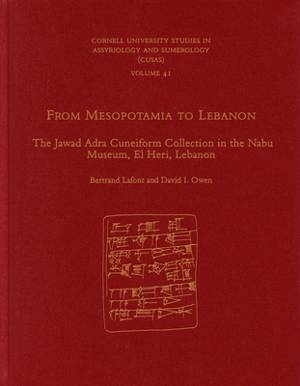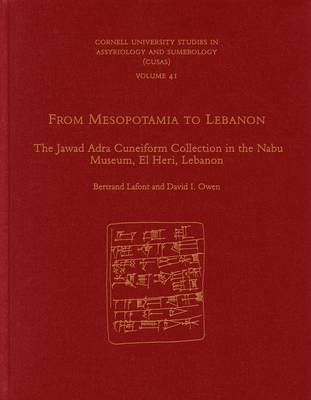
- Retrait gratuit dans votre magasin Club
- 7.000.000 titres dans notre catalogue
- Payer en toute sécurité
- Toujours un magasin près de chez vous
- Retrait gratuit dans votre magasin Club
- 7.000.0000 titres dans notre catalogue
- Payer en toute sécurité
- Toujours un magasin près de chez vous
From Mesopotamia to Lebanon
The Jawad Adra Cuneiform Collection in the Nabu Museum, El Heri, Lebanon
David I Owen, Bertrand LaFontDescription
This volume presents critical editions of tablets from the Early Dynastic, Sargonic, Ur III, Old Babylonian, and Middle Babylonian periods, housed in the Jawad Adra Cuneiform Collection in the Nabu Museum in El Heri, Lebanon. Bringing together a wide range of administrative, literary, historical, and lexical texts, From Mesopotamia to Lebanon is a valuable survey of representative documents from the third and second millennia BCE in Mesopotamia.
Culled from the most significant collection of cuneiform tablets in Lebanon, the documents published here mainly derive from southern Iraq. Despite a wide chronological span, internal evidence indicates that they likely originate from various sites in two main areas: the first close to the ancient bank of the Tigris River, in the ancient cities of Adab, Irisaĝrig, and Umma and their environs; the second along the bank of the Euphrates River, in and around the cities of Isin and Shuruppak. The presence of school and literary tablets within the archival group suggests that one or more of these sites contained a scribal school. Taken together, the texts of the Adra Collection cover one and a half millennia (2600-1100 BCE), from the early period of the Sumerian city-states to the time when the region was ruled successively by the kings of Akkad, followed by the kingdoms of Ur, Isin, Larsa, and, finally, Babylon.
The two editors and six contributors represent an international group of scholars who provide critical editions of texts in their respective areas of expertise. In addition to the editors, the contributors to this volume are Alhena Gadotti, Alexandra Kleinerman, Camille Lecompte, Nordine Ouraghi, Jacques Quillien, and Wilfred van Soldt.
Spécifications
Parties prenantes
- Auteur(s) :
- Editeur:
Contenu
- Nombre de pages :
- 208
- Langue:
- Anglais
- Collection :
- Tome:
- n° 41
Caractéristiques
- EAN:
- 9781575067421
- Date de parution :
- 01-12-24
- Format:
- Livre relié
- Format numérique:
- Genaaid
- Dimensions :
- 216 mm x 279 mm
- Poids :
- 875 g

Les avis
Nous publions uniquement les avis qui respectent les conditions requises. Consultez nos conditions pour les avis.






